Control of cytomegalovirus in bone marrow transplantation chimeras lacking the prevailing antigen-presenting molecule in recipient tissues rests primarily on recipient-derived CD8 T cells
- PMID: 9733809
- PMCID: PMC110079
- DOI: 10.1128/JVI.72.10.7733-7744.1998
Control of cytomegalovirus in bone marrow transplantation chimeras lacking the prevailing antigen-presenting molecule in recipient tissues rests primarily on recipient-derived CD8 T cells
Abstract
Cytomegalovirus (CMV) infection during the transient immunodeficiency after bone marrow transplantation (BMT) develops into disease unless antiviral CD8 T cells are restored in due course. Histoincompatibility between donor and recipient is associated with increased risk. Complications may include a rejection response against the foreign major histocompatibility complex (MHC) antigens and a lack of antiviral control resulting from a misfit between donor-derived T cells and the antigenic viral peptides presented in recipient tissues. Here we have established a murine model of CMV disease after experimental BMT performed across a single MHC class I disparity. Specifically, BALB/c bone marrow cells expressing the prevailing antigen-presenting molecule Ld were transplanted into the Ld gene deletion mutant BALB/c-H-2(dm2), an experimental setting that entails a selective risk of host-versus-graft but not graft-versus-host response. The reconstituted T-cell population proved to be chimeric in that it consisted of Ld-positive donor-derived and Ld-negative recipient-derived cells. Pulmonary infiltrates did not include cytolytic T cells directed against Ld. This finding implies that the infection did not trigger a host-versus-graft response. Notably, upon adoptive transfer, donor-derived CD8 T cells preferentially protected tissues of donor genotype, whereas recipient-derived CD8 T cells protected tissues of either genotype. We infer from these data that the focus on immunodominant antigens presented by Ld within the donor cell population distracted the donor T cells from protecting recipient tissues and that protection in the chimeras was therefore primarily based on recipient T cells. As a consequence, T-cell chimerism after BMT should give a positive prognosis with respect to control of CMV.
Figures
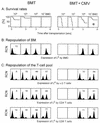
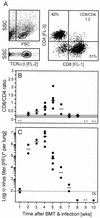
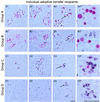


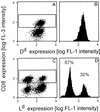

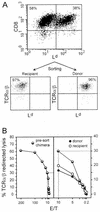
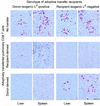
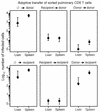
References
-
- Azuma M, Cayabyab M, Phillips J H, Lanier L L. Requirements for CD28-dependent T cell-mediated cytotoxicity. J Immunol. 1993;150:2091–2101. - PubMed
-
- Billingham R E, Brent L, Medawar P B. Actively acquired tolerance of foreign cells. Nature (London) 1953;172:603–606. - PubMed
-
- Charlton B, Auchincloss H, Jr, Fathman C G. Mechanisms of transplantation tolerance. Annu Rev Immunol. 1994;12:707–734. - PubMed
Publication types
MeSH terms
LinkOut - more resources
Full Text Sources
Medical
Research Materials

